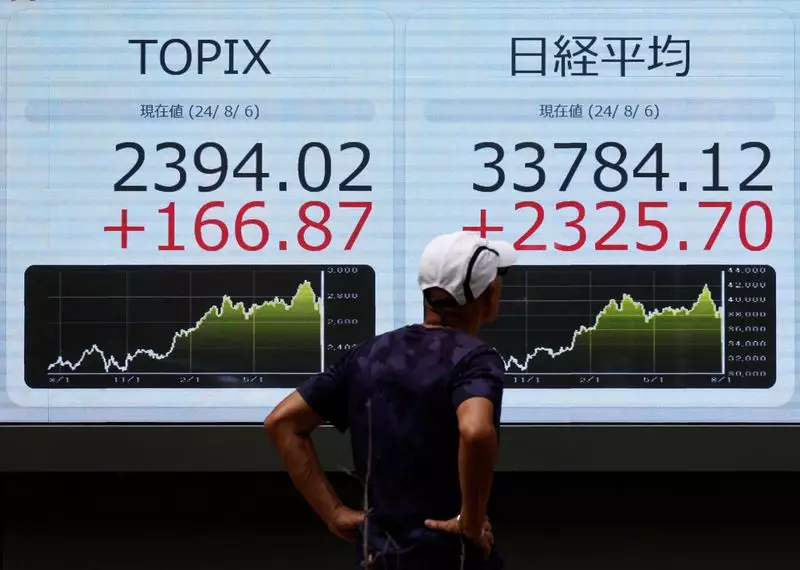Stock markets across Asia are experiencing a notable surge, reaching their highest levels in over two months. This uptick comes against a backdrop of heightened optimism fueled by expectations of potential interest rate cuts in the United States. Investors are closely monitoring the decisions from major central banks, particularly Australia’s Reserve Bank, as they anticipate fiscal strategies that may influence global economic trends.
U.S. Federal Reserve recently implemented a notable 50 basis point cut, igniting discussions about the possibility of further cuts in upcoming meetings. This dovish pivot has not only prompted traders to reassess their positions but has also instilled a sense of confidence in riskier assets across the region. Although the Reserve Bank of Australia (RBA) is likely to maintain its current rates for now, market participants are contemplating the implications of the Fed’s decision on Australia’s monetary policy.
The Australian economy is currently under scrutiny, especially with upcoming data releases that could affect the RBA’s stance. Charu Chanana, an expert at Saxo, has indicated that the RBA may adopt a cautious approach in its upcoming meetings. The anticipation of a November 5 policy decision will hinge significantly on forthcoming labor market statistics and the consumer price index (CPI) report for the third quarter. Chanana asserts that the RBA may only consider a more accommodative stance depending on how these indicators unfold.
The cautious approach from the RBA is reflected in the steady movement of Asian markets, exemplified by the MSCI’s index, which showed a slight increase amidst the evolving economic scenario. Japan’s Nikkei index, contrastingly, depicted a more significant jump of 1.69%, buoyed by positive trader sentiment as it approached a near-three-week high.
Signs of policy support are also evident in China, where top financial regulators have proposed several measures to reinvigorate the nation’s sluggish economy. Notably, the central bank has announced a reduction in mortgage rates for existing homeowners as part of its broader strategy to stimulate growth. The proactive measures suggest that Chinese authorities are mindful of current economic challenges and are taking steps to bolster consumer confidence.
On a related note, the People’s Bank of China recently reduced its 14-day repo rate by 10 basis points, although the market had anticipated more aggressive longer-term rate cuts. Investors are keeping a keen eye on how these developments translate into tangible economic recovery, as any signs of weakness could alter the competitive landscape in Asia.
Within the global financial landscape, the ramifications of the Fed’s actions are twofold. On one hand, a more dovish Fed can support risk appetite; on the other, it can create volatility in currency markets. The U.S. dollar index remains precariously poised, currently at 100.95, not too far from its one-year low. As traders digest the implications of ongoing economic indicators, fluctuations in currency values, especially against growth-sensitive currencies, will be inevitable.
The yen has shown stability against the dollar, maintaining its position at approximately 143.65 per dollar. Conversely, the euro stands firm at $1.11055, despite some recent disappointments in economic activity reports from within the Eurozone, which signal potential for further interest rate adjustments by the European Central Bank.
In Australia, the nation’s dollar has slightly dipped but continues to hover around a nine-month high, reflecting underlying strengths in certain economic metrics, even as investors tread cautiously.
Commodities also reflect mixed sentiments, with oil prices experiencing slight rises despite prior declines driven by concerns over demand and economic data from Europe. As Brent crude futures hover around $74.09 per barrel and U.S. crude maintains a steady price at approximately $70.6, traders are weighing their positions amid fluctuating economic indicators.
The resilience of the commodities market, alongside the strategic maneuvers from central banks, is indicative of broader sentiments within the global economy, as stakeholders assess potential outcomes from policy changes. The interplay between international policies and domestic economic realities will continue to drive market dynamics in the coming weeks.
The landscape of Asian markets is characterized by optimism influenced by U.S. monetary policy, strategic economic support from China, and cautious anticipation of Australia’s decisions. As the global economic narrative unfolds, the interactions between these elements will shape investment strategies and market movements in this dynamic environment.

